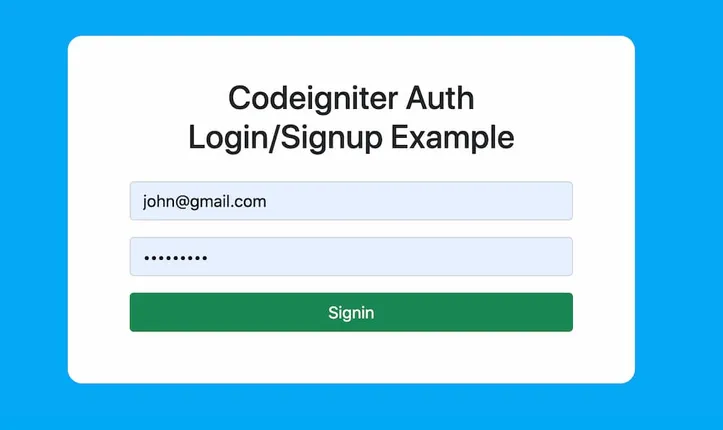Codeigniter 4 Authentication Login And Registration Tutorial
Apr 23, 2022 . Admin

Hi Dev,
This article will give you an example of the Codeigniter 4 login and registration tutorial example. This post will give you a simple example of login and registration in Codeigniter 4. In this article, we will implement a Codeigniter 4 login and registration. I explained simply step by step Codeigniter 4 Authentication Login And Registration Tutorial Example. Alright, let’s dive into the steps.
I will tell you how to create a simple auth system with login and sign-up functionalities. We will specifically use the Codeigniter 4 session to store the state of authenticated users. The login process is done then the user successfully logs into an application.
So let's start to the example.
Step 1: Install Codeigniter 4This is optional; however, if you have not created the codeigniter app, then you may go ahead and execute the below command:
composer create-project codeigniter4/appstarter ci-newsStep 2 : Basic Configurations
So in this step we will now set the basic configuration on the app/config/app.php file, so let’s implement to application/config/config.php and open this file on the text editor.
app/config/app.phppublic $baseURL = 'http://localhost:8080'; To public $baseURL = 'http://localhost/example/';Step 3: Generate Table Into Database
In this third step to generate a database table in your application database.
CREATE TABLE users (
id INT PRIMARY KEY AUTO_INCREMENT,
name VARCHAR(150),
email VARCHAR(150),
password VARCHAR(150),
created_at TIMESTAMP DEFAULT CURRENT_TIMESTAMP
) ENGINE=INNODB;
Step 4: Connect CI to Database
In your app/Config/Database.php, and insert database name, username and password into the file.
public $default = [
'DSN' => '',
'hostname' => 'localhost',
'username' => 'root',
'password' => '',
'database' => 'codeigniter_db',
'DBDriver' => 'MySQLi',
'DBPrefix' => '',
'pConnect' => false,
'DBDebug' => (ENVIRONMENT !== 'development'),
'cacheOn' => false,
'cacheDir' => '',
'charset' => 'utf8',
'DBCollat' => 'utf8_general_ci',
'swapPre' => '',
'encrypt' => false,
'compress' => false,
'strictOn' => false,
'failover' => [],
'port' => 3306,
];
Step 5: Create and Update User Model
In this step we need to create a user model in your CodeIgniter 4 application.
app/Models/UserModel.php
<?php
namespace App\Models;
use CodeIgniter\Model;
class UserModel extends Model{
protected $table = 'users';
protected $allowedFields = [
'name',
'email',
'password',
'created_at'
];
}
Step 6: Register Auth Controllers
We need to Create SignupController.php file in the app/Controllers directory, then insert the below code into the file.
app/Controllers/SignupController.php
<?php
namespace App\Controllers;
use CodeIgniter\Controller;
use App\Models\UserModel;
class SignupController extends Controller
{
/**
* Write code on Method
*
* @return response()
*/
public function index()
{
helper(['form']);
$data = [];
echo view('signup', $data);
}
/**
* Write code on Method
*
* @return response()
*/
public function store()
{
helper(['form']);
$rules = [
'name' => 'required|min_length[2]|max_length[50]',
'email' => 'required|min_length[4]|max_length[100]|valid_email|is_unique[users.email]',
'password' => 'required|min_length[4]|max_length[50]',
'confirmpassword' => 'matches[password]'
];
if($this->validate($rules)){
$userModel = new UserModel();
$data = [
'name' => $this->request->getVar('name'),
'email' => $this->request->getVar('email'),
'password' => password_hash($this->request->getVar('password'), PASSWORD_DEFAULT)
];
$userModel->save($data);
return redirect()->to('/signin');
}else{
$data['validation'] = $this->validator;
echo view('signup', $data);
}
}
}
app/Controllers/ProfileController.php
<?php
namespace App\Controllers;
use CodeIgniter\Controller;
class ProfileController extends Controller
{
/**
* Write code on Method
*
* @return response()
*/
public function index()
{
$session = session();
echo "Hello : ".$session->get('name');
}
}
app/Controllers/SigninController.php
<?php
namespace App\Controllers;
use CodeIgniter\Controller;
use App\Models\UserModel;
class SigninController extends Controller
{
/**
* Write code on Method
*
* @return response()
*/
public function index()
{
helper(['form']);
echo view('signin');
}
/**
* Write code on Method
*
* @return response()
*/
public function loginAuth()
{
$session = session();
$userModel = new UserModel();
$email = $this->request->getVar('email');
$password = $this->request->getVar('password');
$data = $userModel->where('email', $email)->first();
if($data){
$pass = $data['password'];
$authenticatePassword = password_verify($password, $pass);
if($authenticatePassword){
$ses_data = [
'id' => $data['id'],
'name' => $data['name'],
'email' => $data['email'],
'isLoggedIn' => TRUE
];
$session->set($ses_data);
return redirect()->to('/profile');
}else{
$session->setFlashdata('msg', 'Password is incorrect.');
return redirect()->to('/signin');
}
}else{
$session->setFlashdata('msg', 'Email does not exist.');
return redirect()->to('/signin');
}
}
}
Step 7: Create Auth View
Next step we require create a auth view file in your application under directiory;
app/View/signup.php
<!doctype html>
<html lang="en">
<head>
<meta charset="utf-8">
<meta name="viewport" content="width=device-width, initial-scale=1">
<title>Codeigniter 4 Authentication Login And Registration Tutorial Example - Mywebtuts.com</title>
<link href="https://cdn.jsdelivr.net/npm/bootstrap@5.0.2/dist/css/bootstrap.min.css" rel="stylesheet">
</head>
<body>
<div class="container mt-5">
<div class="row justify-content-md-center">
<div class="col-5">
<h2>Register User</h2>
<?php if(isset($validation)):?>
<div class="alert alert-warning">
<?= $validation->listErrors() ?>
</div>
<?php endif;?>
<form action="<?php echo base_url(); ?>/SignupController/store" method="post">
<div class="form-group mb-3">
<input type="text" name="name" placeholder="Name" value="<?= set_value('name') ?>" class="form-control" >
</div>
<div class="form-group mb-3">
<input type="email" name="email" placeholder="Email" value="<?= set_value('email') ?>" class="form-control" >
</div>
<div class="form-group mb-3">
<input type="password" name="password" placeholder="Password" class="form-control" >
</div>
<div class="form-group mb-3">
<input type="password" name="confirmpassword" placeholder="Confirm Password" class="form-control" >
</div>
<div class="d-grid">
<button type="submit" class="btn btn-dark">Signup</button>
</div>
</form>
</div>
</div>
</div>
</body>
</html>
app/View/signin.php
<!doctype html>
<html lang="en">
<head>
<meta charset="utf-8">
<meta name="viewport" content="width=device-width, initial-scale=1">
<title>Codeigniter 4 Authentication Login And Registration Tutorial Example - Mywebtuts.com</title>
<link href="https://cdn.jsdelivr.net/npm/bootstrap@5.0.2/dist/css/bootstrap.min.css" rel="stylesheet">
</head>
<body>
<div class="container">
<div class="row justify-content-md-center">
<div class="col-5">
<h2>Login in</h2>
<?php if(session()->getFlashdata('msg')):?>
<div class="alert alert-warning">
<?= session()->getFlashdata('msg') ?>
</div>
<?php endif;?>
<form action="<?php echo base_url(); ?>/SigninController/loginAuth" method="post">
<div class="form-group mb-3">
<input type="email" name="email" placeholder="Email" value="<?= set_value('email') ?>" class="form-control" >
</div>
<div class="form-group mb-3">
<input type="password" name="password" placeholder="Password" class="form-control" >
</div>
<div class="d-grid">
<button type="submit" class="btn btn-success">Signin</button>
</div>
</form>
</div>
</div>
</div>
</body>
</html>
Step 8: Protect Route With Filter
In the next step, get inside the app/Config/Filters.php, look for $aliases array and replace the whole array with the recommended code.
app/Config/Filters.php
public $aliases = [
'csrf' => \CodeIgniter\Filters\CSRF::class,
'toolbar' => \CodeIgniter\Filters\DebugToolbar::class,
'honeypot' => \CodeIgniter\Filters\Honeypot::class,
'authGuard' => \App\Filters\AuthGuard::class,
];
app/Filters/AuthGuard.php
<?php
namespace App\Filters;
use CodeIgniter\HTTP\RequestInterface;
use CodeIgniter\HTTP\ResponseInterface;
use CodeIgniter\Filters\FilterInterface;
class AuthGuard implements FilterInterface
{
/**
* Write code on Method
*
* @return response()
*/
public function before(RequestInterface $request, $arguments = null)
{
if (!session()->get('isLoggedIn')){
return redirect()->to('/signin');
}
}
/**
* Write code on Method
*
* @return response()
*/
public function after(RequestInterface $request, ResponseInterface $response, $arguments = null)
{
}
}
app/Config/Routes.php
// custom routes
$routes->get('/', 'SignupController::index');
$routes->get('/signup', 'SignupController::index');
$routes->get('/signin', 'SigninController::index');
$routes->get('/profile', 'ProfileController::index',['filter' => 'authGuard']);
Step 9: Run Codeigniter App:
All the required steps have been done, now you have to type the given below command and hit enter to run the Codeigniter app:
php spark serve
Now, Go to your web browser, type the given URL and view the app output:
http://localhost:8080/Output

Now you can check your own.
I hope it can help you...
